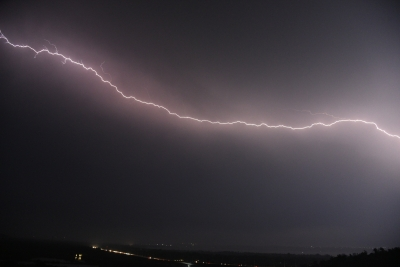Automatic sirens in Andhra villages to protect people from lightning, floods
By IANS | Updated: September 16, 2025 16:05 IST2025-09-16T16:00:57+5:302025-09-16T16:05:19+5:30
Amaravati, Sep 16 Andhra Pradesh government is installing automatic sirens at village secretariats to protect citizens from lightning ...

Automatic sirens in Andhra villages to protect people from lightning, floods
Amaravati, Sep 16 Andhra Pradesh government is installing automatic sirens at village secretariats to protect citizens from lightning and floods, a top official said on Tuesday.
A pilot project in one village has already shown excellent results, with sirens operating through ISRO satellite support even without mobile signals, Secretary, Real Time Governance (RTGS), Katamneni Bhaskar, said.
Each system costs around Rs 2 lakh. Statewide implementation would cost about Rs 340 crore, but in the first phase, vulnerable villages will be prioritised at a cost of Rs 10–15 crore, he said, asking the district Collectors to monitor and support this initiative.
Addressing the District Collectors on the second day of the Collectors’ Conference, Bhaskar said that the state government is enhancing disaster preparedness and governance efficiency through RTGS Aware 2.0, advanced data systems, and innovation hubs.
He urged the district Collectors to fully utilise these cutting-edge tools to improve governance at the district level.
Through RTGS Aware 2.0, citizens are being continuously alerted about disasters, cyclones, lightning, and weather changes. Forecasts down to the mandal level, including lightning strikes, heavy rainfall, and reservoir inflows, are being provided in real time.
He said that a dedicated RTGS Aware website has been launched, already widely used by private transport and logistics firms to plan operations. He urged district administrations to leverage this system for greater local impact.
Bhaskar informed that all district-level RTGS centres will be completed by the end of October. Collectors were asked to personally review progress and ensure the timely completion of construction works.
A centralised Data Lake with over 6 petabytes of data from government departments has been created, linked to a real-time Data Lens dashboard. This tool enables Collectors to access district-level data instantly, eliminating duplication of efforts. He instructed that no new data silos be created at the district level and that existing data must be integrated with the central system.
To make governance information accessible, RTGS has developed an AI-enabled single search bar with over 80 lakh government documents, including GOs. Citizens can access information from any department through this tool, which also features voice-based interaction. Collectors were directed to create awareness among the public on its usage.
The state aims to achieve full mobile connectivity across tribal and remote areas within six months. Bhaskar said steps are underway to immediately address connectivity gaps by constructing new mobile towers in underserved areas.
Collectors were also asked to give special attention to the Ratan Tata Innovation Hub, being established at Amaravati, Visakhapatnam, Vijayawada, Tirupati, Anantapur, and Rajahmundry. These hubs will promote 20,000 startups and generate nearly one lakh employment opportunities for the state’s youth.
"RTGS is not just a monitoring mechanism; it is a people’s tool for disaster preparedness, governance transparency, and future-ready innovation. District Collectors must ensure its full utilisation to bring visible results to citizens," Bhaskar said.
Disclaimer: This post has been auto-published from an agency feed without any modifications to the text and has not been reviewed by an editor
Open in app